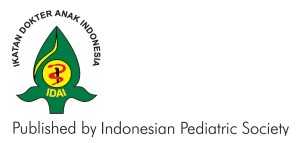Pulmonary arteriovenous malformation as a cause of exercise intolerance in children: a case report
Abstract
Pulmonary arteriovenous malformations (PAVMs) in children are rare lesions characterized by abnormal low resistance vascular structures connecting a pulmonary artery to a pulmonary vein, resulting in an intrapulmonary right-to-left shunt. The insidious onset and variable signs and symptoms make diagnosis difficult, especially in children. PAVMs can be single or multiple, congenital or acquired, and up to 47-80% of cases are associated with hereditary hemorrhagic telangiectasia (HHT).
References
2. Mowers KL, Sekarski L, White AJ, Grady RM. Pulmonary arteriovenous malformations in children with hereditary hemorrhagic telangiectasia: a longitudinal study. Pulm Circ. 2018;8:2045894018786696. DOI: https://doi.org/10.1177/2045894018786696.
3. Feinstein JA, Moore P, Rosenthal DN, Puchalski M, Brook MM. Comparison of contrast echocardiography versus cardiac catheterization for detection of pulmonary arteriovenous malformations. Am J Cardiol. 2002;89:281-5. DOI: https://doi.org/10.1016/s0002-9149(01)02228-7.
4. Chang RK, Alejos JC, Atkinson D, Jensen R, Drant S, Galindo A, et al. Bubble contrast echocardiography in detecting pulmonary arteriovenous shunting in children with univentricular heart after cavopulmonary anastomosis. J Am Coll Cardiol. 1999;33:2052-8. DOI: https://doi.org/10.1016/s0735-1097(99)00096-0.
5. Shovlin CL. Pulmonary arteriovenous malformations. Am J Respir Crit Care Med. 2014;190:1217-28. DOI: https://doi.org/10.1164/rccm.201407-1254CI.
6. Rotondo E, Sgrazzutti L, Attanasi M, Petrosino MI, Chiarelli F, Di Pillo S. When polycythemia and exertional dyspnea are not asthma. Pneumologia Pediatrica. 2019;19:21-5. Www.simri.it. Accessed on 05, 2nd 2023.7)
7. Khurshid I, Downie GH. Pulmonary arteriovenous malformation. Postgrad Med J. 2002;78:191-7. DOI: https://doi.org/10.1136/pmj.78.918.191.
8. Wong HH, Chan RP, Klatt R, Faughnan ME. Idiopathic pulmonary arteriovenous malformations: clinical and imaging characteristics. Eur Respir J. 2011;38:368-75. DOI: https://doi.org/10.1183/09031936.00075110.
9. Sladden D, Casha A, Azzopardi C, Manchè A. A large pulmonary arteriovenous malformation causing cerebrovascular accidents. BMJ Case Rep. 2015;2015:bcr-2014207786. DOI: https://doi.org/10.1136/bcr-2014-207786.
10. Meek ME, Meek JC, Beheshti MV. Management of pulmonary arteriovenous malformations. Semin Intervent Radiol. 2011;28:24-31. DOI: https://doi.org/10.1055/s-0031-1273937.
Copyright (c) 2023 Pierluigi Morreale, Veronica Notarbartolo, Giancarlo Allegro, Mario Giuseppe Vallone, Francesca Finazzo, Vincenzo Antona, Maria Fiorella Sanfilippo, Calogero Comparato

This work is licensed under a Creative Commons Attribution-NonCommercial-ShareAlike 4.0 International License.
Authors who publish with this journal agree to the following terms:
Authors retain copyright and grant the journal right of first publication with the work simultaneously licensed under a Creative Commons Attribution License that allows others to share the work with an acknowledgement of the work's authorship and initial publication in this journal.
Authors are able to enter into separate, additional contractual arrangements for the non-exclusive distribution of the journal's published version of the work (e.g., post it to an institutional repository or publish it in a book), with an acknowledgement of its initial publication in this journal.

This work is licensed under a Creative Commons Attribution-NonCommercial-ShareAlike 4.0 International License.
Accepted 2023-06-27
Published 2023-06-27











